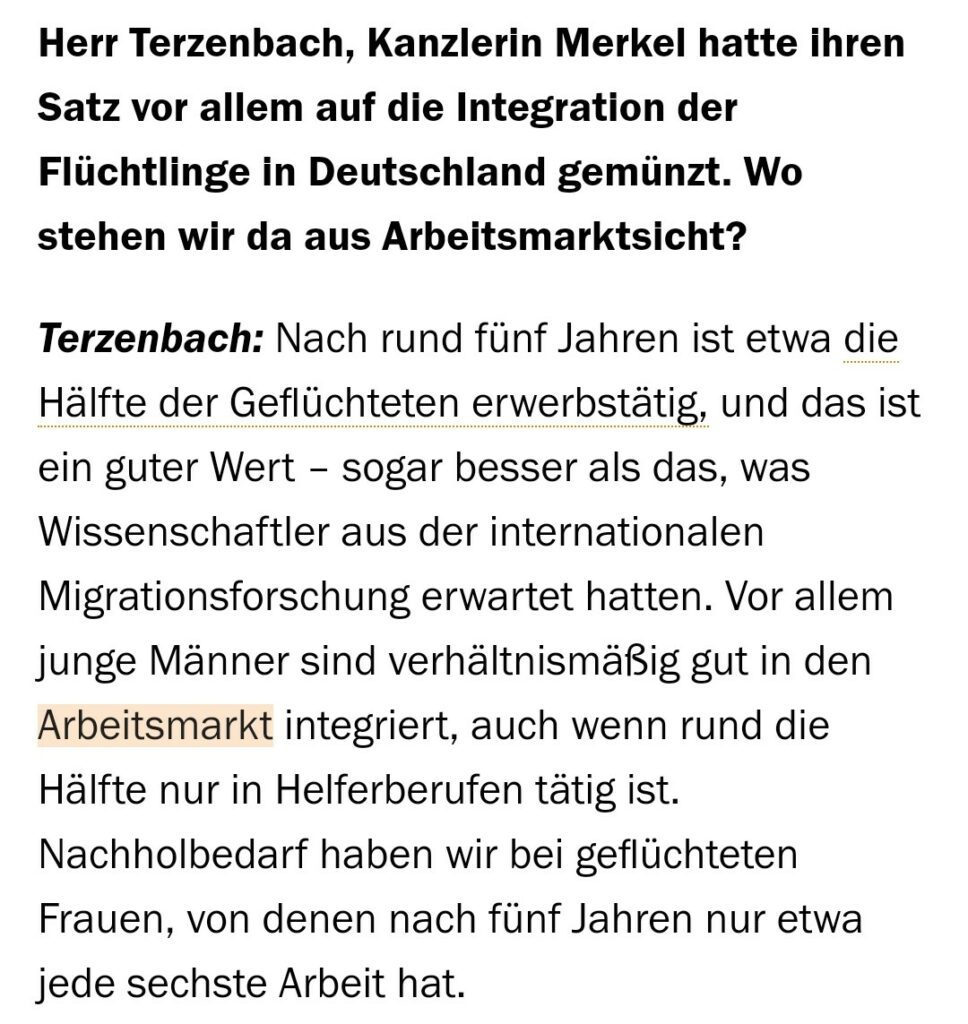In an interview with the German newspaper Handelsblatt, that was published on 7 October 2020 on the website of the Düsseldorfer media outlet, Daniel Terzenbach, board member of the Federal Employment Agency (Bundesagentur für Arbeit), claimed, that after about five years, approximately half of refugees are employed. The claim turns out to be mostly true.
In 2015, Germany witnessed its biggest influx of refugees since the end of the second world war, welcoming 890.000 people seeking protection according to the Federal Ministry of the Interior (Bundesministerium des Innern, für Bau und Heimat). In total, from the beginning of 2013 till the end of 2018, the number of refugees in Germany increased by 1.2 million according to the Institute for Employment Research (Institut für Arbeitsmarkt-und Berufsforschung).
2020 thus marked the five-year anniversary of the peak of the influx. Because of this occasion Daniel Terzenbach together with the president of the Federal Agency of Migration and Refugees (Bundesamt für Migration und Flüchtlinge) Hans-Eckhard Sommer gave an interview to the German newspaper Handelsblatt. In this, Terzenbach amongst other things claimed that after about five years, approximately half of refugees are employed.
Assessments from experts and stats on the employment of refugees
Terzenbach had failed to mention any source in his statement. However, another German newspaper, Welt, reported similar results regarding the employment of refugees while referring to a document as their source, a short report from the Institute for Employment Research. The report includes a graphic that shows the development of employment of refugees in Germany over time, tying in with what Terzenbach said. The authors thus concluded, that Terzenbach must have based his statement on this graphic, which results stem from a survey carried out by the Federal Agency of Migration and Refugees in cooperation with the Institute for Employment Research, the Federal Employment Agency and the Socio-Economic Panel (Sozio-oekonomischen Panel -SOEP) of the German Institute for Economic Research (Deutsches Institut für Wirtschaftsforschung -DIW) titled IAB-BAMF-SOEP-Befragung von Geflüchteten 2018.
The survey concluded that five years after coming to Germany, 49 percent of refugees (48 percent after final weighting) were employed. 68 percent of these refugees worked either full-time or part-time, 17 percent did an apprenticeship, 3 percent did a paid internship and 12 percent were marginally employed. Thus, on the face of it, Terzenbach seemed to be right when he said, that about half of refugees are employed after about five years.
However, it is important to note that the conductors of the study only regarded refugees as employed who did paid work. Refugees working for free were not considered employed. Also, only refugees between the age of 18 and 64 who came to Germany between the beginning of 2013 and the end of 2016 were surveyed. Taking the framework of the survey into account, Terzenbach’s statements is thus only true for the above-mentioned refugees and not applicable to refugees arriving in any other country or to Germany before 2013 or after 2016.
Nevertheless, when confronted with Terzenbach’s statement, two experts, Prof. Dr. Klaus F. Zimmermann, Professor of Economics at the University of Bonn and Honorary Professor at the Free University of Berlin, the Renmin University of China, the Maastricht University and the Lixin University of Shanghai and Dr. Thomas Liebig, Senior Migration Specialist in the Department for International Migration of the OECD, confirmed its truthfulness. To make clear how important the integration of refugees into the labourmarket is, one must look at the current refugee situation in Germany.
Present refugee and migration situation in Germany
As mentioned in the beginning, several years have gone by since the peak of the influx of refugees in Germany. According to the Federal Agency of Migration and Refugees, in 2020, Germany recorded its lowest number of asylum-seekers since 2012. However, Germany remains one of the largest recipients of asylum applications in the world. In 2020, only the USA received more applications (about 250.000) than Germany (about 100.000) according to the United Nations High Commissioner for Refugees. The UNHCR also claims that Germany hosts 1.2 million refugees, the fifth most by any country in the world and second most in Europe behind only Turkey. Seeing that there are still new refugees seeking asylum in Germany every year, the integration of refugees into the labourmarket remains a constant challenge.
Conclusion
In short, the integration of refugees into the labourmarket remains a constant challenge as new refugees are seeking asylum in Germany every year. Germany is currently home to more than one million refugees. Most of whom came to Germany between 2013 and 2018. All stats and assessments of experts back up Terzenbach’s statement regarding the employment of refugees, however the truthfulness of the statement is limited to those refugees who came to Germany between 2013 and 2016. Since Terzenbach failed to mention these geographical and temporal limitations in his statement, the claim is only mostly true.
Leave your comments, thoughts and suggestions in the box below. Take note: your response is moderated.
RESEARCH | ARTICLE © Malisa Wille and Philip Kearney, Jade University of Applied Sciences, Wilhelmshaven, Germany






